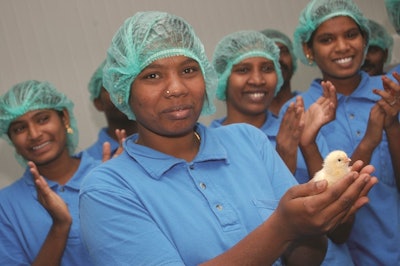
Animal welfare is gaining more attention and it is important for the poultry industry to be transparent about it. Many of us have signed up to responsible, farm animal care initiatives, and are truly dedicated to creating a positive welfare culture across the industry.
Concern about the wellbeing of animals is nothing new. Farmers have always cared about their animals, doing their best to make sure they are healthy and well-nourished and that sick animals receive timely, effective care. Moreover, farmers have long realized that their profits are better with healthy animals.
We continue to recognize that treating birds well is not only the right thing to do but is good for businesses.
What is welfare?
While welfare has different meanings across different cultures and regions, generally, it means ensuring that all an animal’s needs are met including proper nutrition, water and shelter. Welfare means protecting health, preventing pain, illness, injury and distress, promoting comfort and allowing expression of natural behavior.
How are objectives achieved?
We know that health and robustness are important to bird well-being and these characteristics are strengthened through careful selection.
Our selection strategy focuses on reducing clinical and sub-clinical skeletal defects through careful inspection of our birds, assessing walking ability and using non-invasive technology, such as CT scanning.
At the same time, we measure the oxygen saturation levels in blood to assess the birds’ cardiovascular function. This combination of measurements increases the power of selection for welfare traits, leading to stronger birds that perform well for producers.
Birds are given the best care by people who are thoroughly trained in management and have a passion for animal wellbeing. Flocks are given clean water, for example, and feed is formulated to meet unique needs.
Flock environments are kept at optimum temperatures and humidity levels that are continuously monitored while competent stock people observe the birds using all five senses. Smart farming techniques, such as using modern sensors and monitoring systems, assist in this. Regular veterinary care and routine welfare audits are also effective ways to check bird welfare.
Welfare is further strengthened when we spread welfare messaging to our customers and industry colleagues. This is a proven way to ensure birds are well cared for, while championing poultry farmers’ economic success.

How welfare impacts profits
It is in everyone's interest to look after the interests of our birds. The strongest business case for protecting welfare is two-pronged: 1) Public welfare perception can influence consumer buying, and 2) Thriving, healthy flocks are more efficient and perform better, boosting our bottom line.
Healthy animals excel in production at both the breeder and broiler levels. Young chicks that start strong with an optimal body weight and fitness level perform better in converting feed to meat. This is important because feed represents the single greatest cost of a livestock business.
Additionally, the world’s poultry growers operate in a spectrum of conditions. Well-cared-for birds are more resilient and will thrive in diverse climates and production systems.
Balanced breeding
For poultry producers to successfully feed a growing population and sustain strong businesses, breeding objectives should be accomplished in a balanced way.
Bird performance is promoted simultaneously with overall health, welfare and resistance to disease. Balanced breeding creates a ripple of benefits for producers and the birds in their care, while strengthening the ability to provide a safe, affordable, nutritious and sustainable food source.
Poultry biodiversity ensures producer, consumer choice
www.WATTAgNet.com/articles/43215

















